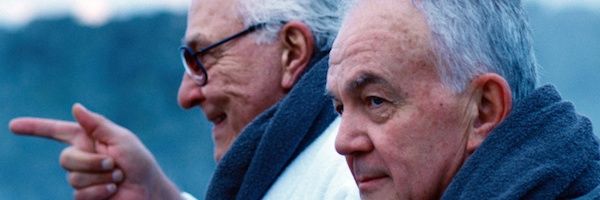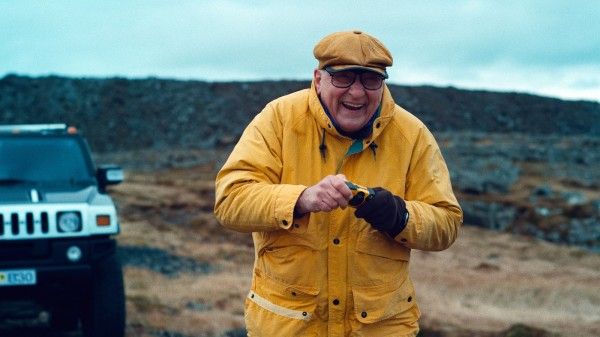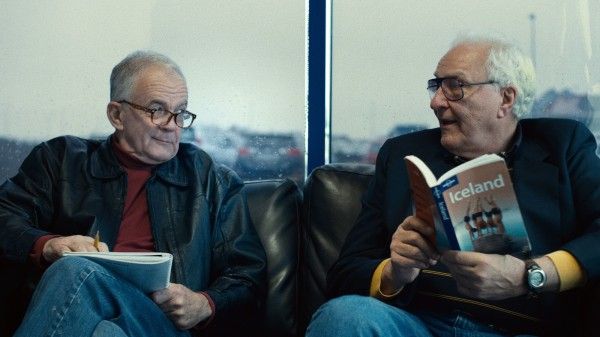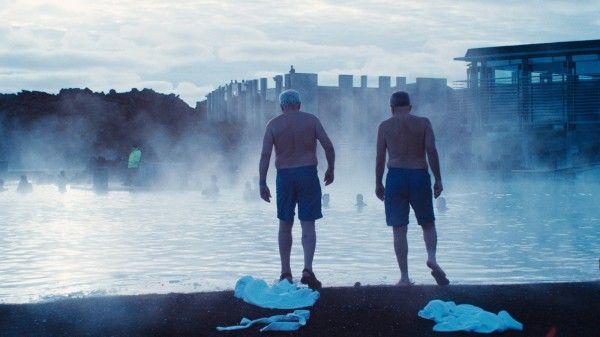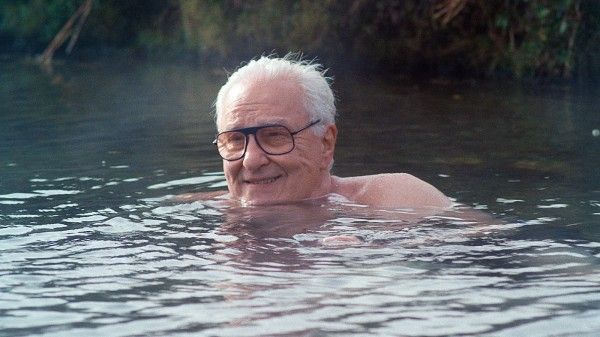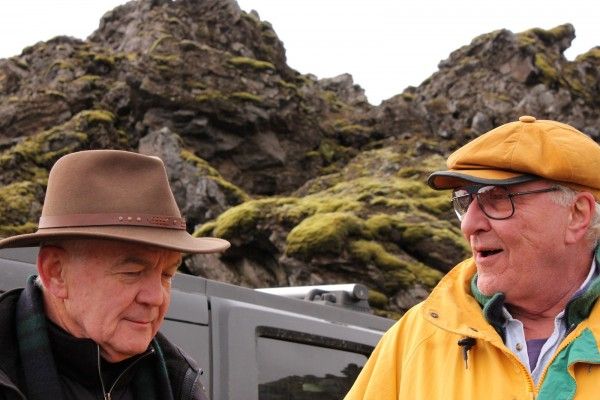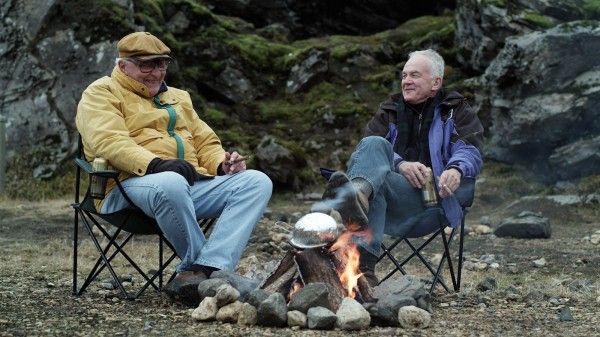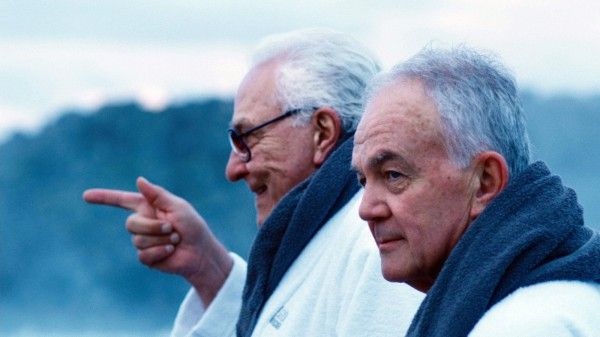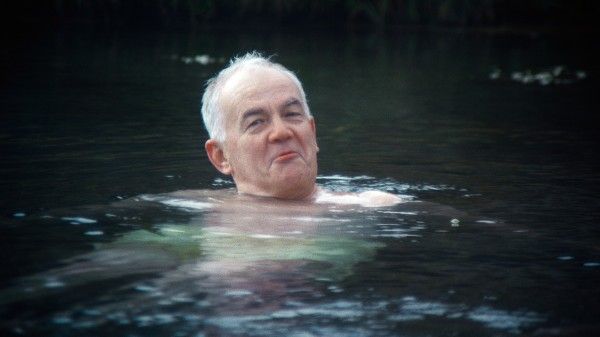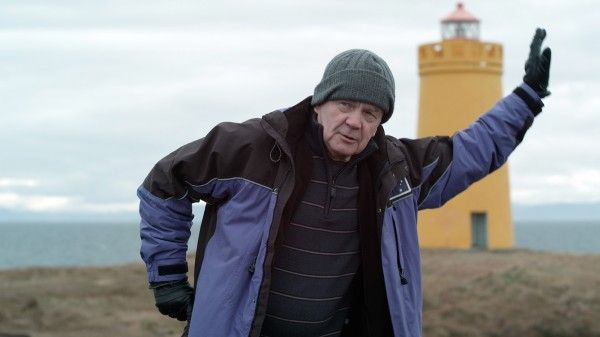Land Ho!’s unconventional and likeable stars, Earl Lynn Nelson and Paul Eenhoorn, take audiences on a bawdy and adventurous road trip across Iceland playing a pair of aging ex-brothers-in-law who rekindle their friendship and joie de vivre while on holiday. Opening July 11th, the quirky comedy written and directed by indie filmmakers Martha Stephens and Aaron Katz embraces life as a never-ending adventure where you’re never too old to reconnect, make new acquaintances, and explore the world around you.
During an entertaining roundtable interview, Nelson and Eenhoorn talked about their filmmaking journey, the appeal of their characters, the grueling production schedule, their odd couple dynamic, setting the story against a stunning Icelandic landscape, the physical demands of shooting on moonless moors and unpredictable geysers, their Star Wars reference, what it was like on set working with two directors, their Sundance experience, what Robert Redford had to say about their film, and what’s next including the possibility of a second movie or a TV series together. Hit the jump for our Land Ho interview.
QUESTION: You guys did the shoot in 18 days in the freezing cold. Tell us a little bit
about this grueling schedule.
PAUL EENHOORN: We need to qualify that, because it was fall and it was getting cold, but Iceland is not always cold.
This is from the Icelandic Tourist Bureau.
EARL LYNN NELSON: Last summer was the worst. It was the coldest summer they had had in 50 years.
EENHOORN: That space film they shot there, what was it called? Interstellar. McConaughey was in it. Apparently they lost weeks during their shoot. They were a multi-million dollar film. But we were blessed. We had one day which we had to call, and apart from that, the weather was good.
NELSON: It was raining sideways. There wasn’t any snow.
EENHOORN: But yeah, it was cold, and it was compact, and it was compressed into a physically demanding film.
You had a lot of chemistry together on screen. Do you think chemistry is something you can work towards through rehearsal and shared time together? Or is it something that’s innate between two people, and either you have it or you don’t?
NELSON: We met each other the day we started filming. That’s when we met for the first time.
EENHOORN: From my perspective, as an actor who has worked for a long time, you look for it in your partner. You seek it out. You search for it. You try and pull it out of the other person, and if it doesn’t come, well then you can see the results on screen. It’s pretty boring.
NELSON: It depends on whether his pants are unzipped or not when you’re trying to pull it out, I guess. (Laughs)
EENHOORN: With Earl Lynn…
NELSON: I never met a stranger. That’s what I can tell you. I’ve never met a stranger.
EENHOORN: But Colin (Eenhoorn’s character) is like a shadow of Mitch (Nelson’s character), because he has to be who he is for Mitch, because there’s no other way. There is no other option in playing Colin’s role than to be who Colin was on that screen, because that’s who they were. But yeah, the chemistry was there because I knew Earl Lynn and I knew what to expect every day. I knew he wasn’t going to change, and therefore I had a good base to build that relationship on. Is that too cerebral?
NELSON: We got to know each other in front of my freezer at my house drinking moonshine out of a Mason jar as well as tequila. I taught him how to do that without wasting any and putting it in a glass before you drink it.
Is there a beauty in life feeling as though you’ve never met a stranger as opposed to some people who live their life believing everyone is a stranger and are pretty much closed off to everyone around them?
NELSON: I love life. I know that because of my experience with death. I spent four years, three months and thirteen days in Vietnam. I found both of my parents dead, and tomorrow, I could be dead. Therefore, I squeeze life for every nickel that I can get out of it every day. I work hard and I play hard. I just love people. I enjoy people. It’s not something that I try to do. It’s not on purpose. I guess it’s just my personality. It’s me. I do surgery three days a week, and I enjoy doing the films because it’s fun. It’s fun make-believe, if you will, like a kid playing Cowboys and Indians. If somebody’s an Indian, I apologize. I don’t mean to get into that.
EENHOORN: That’s a great reference.
NELSON: Or we could say Cowboys and Aboriginals, if you want to instead.
EENHOORN: That’s not going to work.
NELSON: Most people say, this Australian accent (referring to Eenhoorn) with my accent, obviously that’s perfect. How many times have you heard two people’s accents be so geometrically opposed?
EENHOORN: Interestingly, I’m more closed on set than I am off set. On set, I’m closed. I don’t want input. I want to concentrate on what I’m doing with this other person. But outside of that, I’m open. I’m everybody’s friend, unless they don’t like me. And then, I just totally can’t understand that. I actually can’t. I get really hurt if someone doesn’t like me. It’s weird. But on set, I shut everything out and I’m not necessarily friendly. I only just realized that. Thank you for the insight.
NELSON: That’s a bunch of crap.
EENHOORN: That’s true, man. That’s true.
When you first read the script, what was it about your characters that appealed to you?
NELSON: They wrote the script after they picked us to be. It wasn’t the other way, seriously. See, Martha’s my cousin. Her mother and I are first cousins. She knows that I’ve been a scoundrel my whole life. She just called me up and asked me if I’d want to go to Iceland for a month. I said, yeah, I’ll go. They got Paul, and they threw me and Paul together the first weekend. When you see us and I’m vacuuming, that was the first scene in Kentucky. We were there and filmed 15-20 minutes in two days or something like that.
EENHOORN: Yeah, we shot 12 pages, I think.
NELSON: But anyway, with that, then the rest of the script was being written, and we went to Iceland with it.
EENHOORN: If someone comes to you, and you know the directors, and you want to work with them, and they say we’re going to pay you money, and we’re going to fly you to Iceland for 18 days, and we’re not going to work your guts out, it’s like the carrot on the stick. It’s going to be freakin’ freezing and cold, and the conditions are going to be really intolerable. They didn’t tell me that bit. That’s just shooting on a remote location.
DP Andrew Reed does a beautiful job capturing the majesty of Iceland. Did you know before you got there the locations that Martha and Aaron had selected, or was this a great surprise to you and you shuffled through the guidebook to find out where you were going?
EENHOORN: No, I had no idea. I didn’t even open a guidebook, because why would you? This is the story. (Laughs)
NELSON: I got stuck in Iceland when I thought I was going to be a hero heart surgeon. I was studying at St. Bartholomew’s Hospital in London, and Icelandic Airlines was the cheapest way that I could go. It was a $132 roundtrip from New York to London, and you stopped at Bangor, Maine, Newfoundland, Greenland, Iceland, Norway, Scotland, London. And the hub was Reykjavik. If there was anything wrong with the airplane, that’s where we got stuck.
EENHOORN: That was on a DC-3, mind you.
NELSON: It was. It was a DC-3, a converted DC-3. I’m talking about 1967.
EENHOORN: I was joking.
NELSON: I thought it was a beautiful country, but I never got more than four or five miles away from the airport. I loved the food, the lobsters, and the vodka was good. And you’d get beautiful, long-legged, blonde-headed women which was nice.
EENHOORN: The film may appeal to us, but the vision of using Iceland as a part of the painting was deliberate and through Aaron and Martha and Andrew. That was not an accident. It’s similar to Lynn Shelton’s films if you’ve seen them. You have those moments where you see the city and it’s just still. I’m watching Land Ho! for the first time and I can see the references between the directors to Lynn Shelton. It’s that same feeling like they’re just capturing something. It’s also like Chad Hartigan in This Is Martin Bonner. Showing Reno in that fashion was something that no one had ever done before I don’t think.
NELSON: Iceland was so much more beautiful than they could put on the screen. I don’t know if you remember the scene where Paul and I are standing there looking at these magnificent waterfalls that make Niagara Falls look like a creek. They’ve got thousands of waterfalls in Iceland. From the movie and from some of the pictures, I’ve got several of my friends and family members that have already gone to Iceland for a weekend just to check it out because they liked what they saw. They saw some of the pictures we took while we were over there. It’s a beautiful country. The people are friendly and nice. They speak better English than we do. Their country is in pretty bad shape financially so it’s expensive over there, but I think it’s worth it because of what you have. It’s just beautiful.
EENHOORN: It’s got the socio-economic benefits of turning your back on international world banks. Whoops! (Laughs)
What about that scene with the blow holes? Was that tough to capture?
NELSON: You mean the geyser?
EENHOORN: When they called action, the damned thing just didn’t…
NELSON: We’re on call backs and that son-of-a-bitch just came right up like hell. Yeah, right!
EENHOORN: We had to kill some time. The reference to Jaws, we were just standing there and waiting and waiting and going, [he hums the Jaws theme].
NELSON: I was doing the abracadabra, “C’mon out of the hole. C’mon out of the hole.”
EENHOORN: It’s funny if you watch it. The real strucker, the original geyser, is behind us as we’re facing it. That one is the small one. The other one died when some kids threw barrels or something into it.
NELSON: They killed it.
EENHOORN: They killed this geyser and it was huge.
NELSON: They threw rocks and put stuff in there and they killed it.
EENHOORN: It’s the size of this hotel. It’s just like a huge crater. But this one was a small one. There are a few others, but it’s the only one that survives. It bubbles up. You see the bubbles come and then the water rises, and you think here it comes, and then it goes down again. (Laughs) You can’t tell.
NELSON: It explodes about every 5-1/2 to 11 minutes. We talked about that earlier with Aaron. I think we did a total of 20-some minutes of actual filming at the geyser. They cut a bunch of it out because we had to fight the tourists. We’re low budget, and there were tourists all around there, and they were looking at the cameras and wanting to know what we were doing. You couldn’t say, “Get the hell out of there,” because it was their country.
EENHOORN: That’s funny because only once did it actually shoot up. It went twice in a row.
NELSON: And then you saw both in the movie.
EENHOORN: It was totally unexpected. We didn’t expect the second one.
NELSON: The second one came so quick. I couldn’t see my glasses when it was bubbling. I don’t know if you saw Paul wiping my glasses. I couldn’t see anything.
EENHOORN: I thought we’d cut then. I thought we’d actually cut, and so I came back in frame and wiped his glasses, and I heard Andrew Reed say, “Hey, I got that. That’s fucking incredible.”
When you were wandering aimlessly in the night on the moors in the pitch black with just glow sticks, was that movie magic or was that something that actually transpired?
NELSON: You mean about being out there in the middle of the night? Hell yes, we were out there in the middle of the night with those glow sticks. We were too far up in the boonies. You couldn’t get any electricity up there. You couldn’t take any generators. It was done exactly like you saw it.
EENHOORN: They had enough light to establish silhouette.
NELSON: That was it.
EENHOORN: And that was it. They knew that we were going to run out of light sooner or later.
NELSON: We walked out of there in pitch black dark.
EENHOORN: Now I knew when we were shooting that, that there was going to be a Star Wars reference here if the lights sank. I actually waved mine around a lot more than I maybe should have or could have, because I thought this is like Star Wars. I already read it once where someone made that lightsaber reference so that was really funny. But it was… Oh…I’m not going to say that. (Pauses) My lightsaber was bigger than his lightsaber. (Laughs)
NELSON: Mine was pink.
I’m sure you’re aware of some of the feedback about the film and the emotionally cathartic reactions people have shared with you after seeing it. Is a big part of this process just the journey?
NELSON: The journey wasn’t the feedback I’ve gotten. The feedback I’ve gotten is the emotional bonding that people have gone through, situations like what we went through. They’ve identified with that and they embraced it, and they really got into the situation and how we handled it in the movie, and it might be some direction for somebody else in their 20s or 30s or 40s. You don’t have to lose a loved one in your 60s or 70s. You could lose someone when you’re a teenager. You could lose your job when you’re in your 20s. To me, it’s not a movie with a theme behind it about old people losing their job and retiring. It’s about humanity and how you deal with life every day. You reach and grab a handful of guts and go on with your life.
EENHOORN: If you see that line or that development in a script and it’s on screen, it’s because of the directors. It’s because they had a clear vision of what they were doing. I walk into a scene and I do the scene. That’s my job. I don’t have an objective. I have the words and I have whoever I’m playing with. If there’s that arc, then it’s definitely the directors. That’s why, as I say, young directors have an incredible handle on life. The good ones have this insight that they probably shouldn’t really have at their age. It’s really remarkable.
What was it like working with two directors? What was the dynamic like on set?
NELSON: Everybody thinks that the director, because most of them have got such damn wild hair up their ass, that if there’s two of them, they’re going to fight each other, which was totally not true. They went to school together. They’ve known each other for years. I think that because of the short time, one guy couldn’t have done it. The two of them together worked their hineys off and made a 39 cent budget film into something I think is going to blow the roof off. I really do.
EENHOORN: They were one mind.
NELSON: They worked together as a unit. When one was doing this, the other was doing something else, so that it saved time. And then, they would come to the hotel rooms at nighttime before we’d be filming the next day and go over the script and explain to me or Paul what feeling or what they wanted to get across the next day. That was fantastic, because a lot of times the words that were in the script didn’t describe it like I thought it should be described. So I would say, “I would rather say this.” And they’d say, “Well that sounds pretty good,” and they’d make changes. It was like they were malleable. They weren’t like Adolf Hitler standing there saying, “You’re going to do it this way or we’re going to hang you or something.”
EENHOORN: They’re both individuals but they both worked the same way. They both had the same directorial feel to them, even though you get them together and you can see they’re two different people.
NELSON: It was like a family unit. When you were around those people for three or four weeks, everybody there knew everything about everybody. We didn’t stay at the best hotels. I mean we didn’t ever, okay. We shared showers, not necessarily together. We sat and shared shitters, and pissers, and this, that, and the other at these little hotels that we stayed at. We got to know each other pretty damn good because we ate together three times a day. That unit working together I think is what made this movie, not the money that this one had or that one had. It was a family. You just can’t beat the cohesiveness that was there between everybody.
Do you think one of the themes of the film is you’re never too young or too old or too anything to go out and keep on exploring your life and the world around you?
EENHOORN: Hello. I was talking to Steve Albrezzi about this last night and we called it Act 3: The Resolution. My attitude towards that is I’m all in. I’ve got all my chips on the table. There is no Plan B. Albrezzi liked that. He was talking about it because he wants to leave academia. He’s a very good film director. He wants to go right into production. He’s been teaching directing for 30 years. So yeah, we talked about that and we called it The Resolution, because aren’t we the testament to the question? I mean, I’ve been working this for a long time, but life takes you in directions that you may not necessarily want to go, and then you realize that that direction was a totally wrong direction to take. He had that awakening, too. You go back to what you are driven or called to. There’s these two who all of a sudden have got some prominence in the boomer world. I think it’s a good story. I really do.
What are each of you working on next?
NELSON: I’m doing surgery three days a week. I’ve had some people email me and make some phone calls talking about the possibility of us doing a second movie. I’m not going to name specific companies or names or anything like that because they asked me not to. They talked about having a TV series between us two and asked me would I be open to that. I said, “Well, you send me the information and I’ll read it and see what I think. But I’m not going to be flying all over the United States to audition for anything.” My day job is too important to me. I love this movie business. It’s been fun. When I’m there, I give it my all, just like I do when I’m doing surgery. I’m all in. All in.
EENHOORN: I came across a story that someone… I’ve got scripts in development, but one in particular was interesting because it’s a small ensemble piece and I liked the story. I’m looking for an agent. Hello. And I am looking for production funds. So, anyone who’s interested, just give me a call. It’s one step at a time. I’m patient when it comes to my career, which is unlike me, but there are no stars in my eyes. I make where I go. It’s that sort of thing. I’m with him. Don’t ask me to audition because I’ve auditioned too many times already. I’m self-opinionated and I have a sense of self. I can be brutal with agents and have been.
NELSON: Question back to you guys. Did you all like our movie or not?
[All the journalists at our roundtable say they liked it.]
EENHOORN: Like they’re going to say, “It sucks, man. It’s the worst piece of shit I’ve ever seen, but you know, we’re getting paid to be here.”
NELSON: By the way, I asked that question at Sundance. My kids had said they knew I’d probably never get a picture with Robert Redford like one of my kids wanted me to. Remember when we were on the stage, I said, “I’d like to know if Robert Redford liked our movie,” and the guy goes, “Hold on a minute.” He goes over and he makes a phone call. About two minutes later, he says, “Mr. Redford said if he didn’t like it, your movie wouldn’t have been there.”
EENHOORN: That was a huge interview we did at the studios in Sundance in Park City. It was nice.

